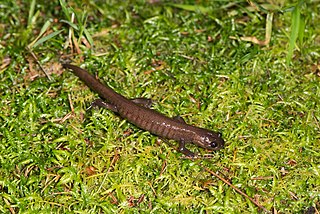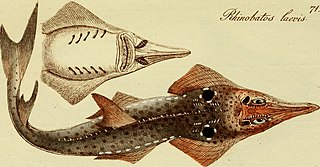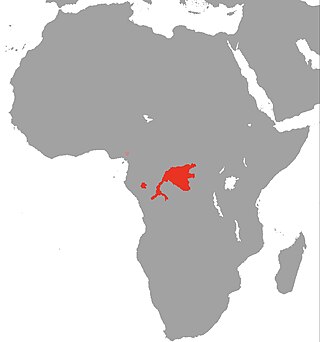
Galaxias olidus, the mountain galaxias, is a species of freshwater galaxiid fish widely found in southeastern Australia.

The silver drummer, also known as the buff bream, buffalo bream, buffs, common buffalo bream, drummer bream, Southern silver drummer or Sydney drummer, is a species of marine ray-finned fish, a sea chub from the family Kyphosidae. It is found in the southeastern Indian Ocean and the southwestern Pacific Ocean off Australia and New Zealand where it is found in shallow water near rocky reefs.

Gymnothorax is a genus of fish in the family Muraenidae found in Atlantic, Indian, and Pacific Oceans. With more than 120 species, it the most speciose genus of moray eels.

The pink frogmouth, or redeye, pink gaper or uniform gaper, is a species of marine ray-finned fish belonging to the family Chaunacidae, the sea toads. This species is found in the Atlantic Ocean.

The Taiwan angelshark is an angelshark in the family Squatinidae. The Taiwan angelshark is one of four species of Squatina in the waters around Taiwan and Japan. It is a demersal, ray-like shark that grows to 1–2 meters in length.

Hemimyzon taitungensis is a species of ray-finned fish in the family Balitoridae that is endemic to Taiwan. It is a small freshwater fish currently known only from running waters of the Central Mountain Range of Taiwan at high and middle elevations. In contrast to H. formosanus, it appears to be a well-defined species with no signs of strong genetic structuring suggestive of cryptic species.

Hemimyzon is a genus of freshwater ray-finned fish belonging to the family Balitoridae, the river or hillstream loaches. The species in this genus are found in eastern Asia.

Hynobius arisanensis, the Alishan salamander, is a species of salamander in the family Hynobiidae endemic to Taiwan. It occurs in the Alishan Range, the Yushan Range, and southern Central Mountain Range, where it lives at altitudes of 1,800–3,600 m (5,900–11,800 ft) above sea level. Its natural habitats are temperate forests, rivers, and freshwater springs. It is usually hiding during day time.

The smoothnose wedgefish is a species of fish in the Rhinidae family. It is found in northern Indian Ocean and northwestern Pacific Ocean, ranging from the Arabian Sea and Persian Gulf east to Bangladesh, and South China Sea to southern Japan. Populations elsewhere are now recognized as separate species. Its natural habitat is shallow coastal seas and off the mouths of rivers. It is threatened by habitat loss and overfishing.

Butis butis, the crazy fish, duckbill sleeper, or upside-down sleeper, is a species of sleeper goby that are native to brackish and freshwater coastal habitats of the Indian Ocean and the western Pacific Ocean from the African coast to the islands of Fiji. They prefer well-vegetated waters and can frequently be found in mangrove swamps. They are small, drably-colored fish, reaching a maximum length of only 15 cm (5.9 in). They are predatory and are known for their behavior of swimming vertically – or even upside down – while hunting.

The Gaoping River, also spelled Kaoping River, is the second longest river in Taiwan after Zhuoshui River with a total length of 184 km (114 mi). It is located on the southern part of the island, flowing through Pingtung County and Kaohsiung City. It is the largest river in Taiwan by drainage area. Draining a rugged area on the western side of the Central Mountain Range.

The checkered puffer is a species in the family Tetraodontidae, or pufferfishes.

The longfin crevalle jack is a recently described species of large marine fish classified in the jack family, Carangidae. It inhabits the subtropical waters of the east Atlantic Ocean, ranging along the African coast from Mauritania south at least to Moçamedes in southern Angola, with the species historically present in the Mediterranean Sea. It is an inshore species, known to occasionally penetrate estuaries, possibly to spawn. The species is very similar to the crevalle jack, Caranx hippos, and is separated by its extended dorsal and anal fin lobes as well as more detailed anatomical features including dorsal and anal fin ray counts. The fish is known to reach 127 cm in length and 20.9 kg in weight. The longfin crevalle jack is a predatory fish, taking small fish as its main prey. Due to longstanding confusion between C. fischeri and C. hippos, the importance of each species to African fisheries is poorly understood, with a known combined catch in this region of between 2,233 and 10,054 tonnes per year in 1995–2004. Like its close relatives, the species is considered a powerful gamefish and highly sought after, although their coarse flesh makes for relatively poor quality food.
The Triton epaulette shark is a species of bamboo shark in the genus Hemiscyllium, that is composed of nine morphologically similar, yet distinct, sharks that are geographically restricted to New Guinea and northern Australia. Hemiscylliidae are small nocturnal sharks aptly named "walking sharks" who exhibit a "crawling" movement while foraging on the ocean floor for fish and benthic invertebrates.
Garra geba is a species of cyprinid fish in the genus Garra. It is endemic to Ethiopia.

The spottail shiner or spottail minnow is a small- to medium-sized freshwater minnow. It can be found as far north as Canada and as far south as the Chattahoochee River in Georgia. These shiners live in lakes, rivers, and creeks. They occupy the rocky or sandy shorelines and bottoms of the water. One of the defining features of a spottail shiner is the black spot found at the base of the caudal fin. These shiners generally spawn from late June through July.
Hemimyzon formosanus is a species of hillstream loach in the genus Hemimyzon. It is endemic to western portion of Central Mountain Range of Taiwan. Its maximum length is 10 cm (3.9 in). Variations in nucleotide sequences within the mitochondrial control region show strong geographic structuring suggestive of a cryptic species complex.

The reticulate unicornfishes is a species of marine ray-finned fish belonging to the family Acanthuridae, the surgeonfishes, unicornfishes and tangs. It is a rare species found on coral reefs in the Indo-West Pacific region.

The West African bichir or retropinnis bichir, is a freshwater fish in the family Polypteridae, is found in the central Congo River basin and Ogooué River in Africa. It is a long, slender fish that grows to a maximum length of about 34 cm (13 in).
Astyanax anai is a small freshwater fish native to Central America. It has a restricted range, inhabiting a handful of Atlantic drainages in Costa Rica and Panama, and is known from locales only up to 100 meters elevation. As an endangered species, A. anai is a point of interest for conservation biologists studying the region. It can be found living sympatrically with other species of Astyanax, but is less common than its relatives.














